Artemis 1 launch: Nasa 'ran out of time' as Moon mission postponed
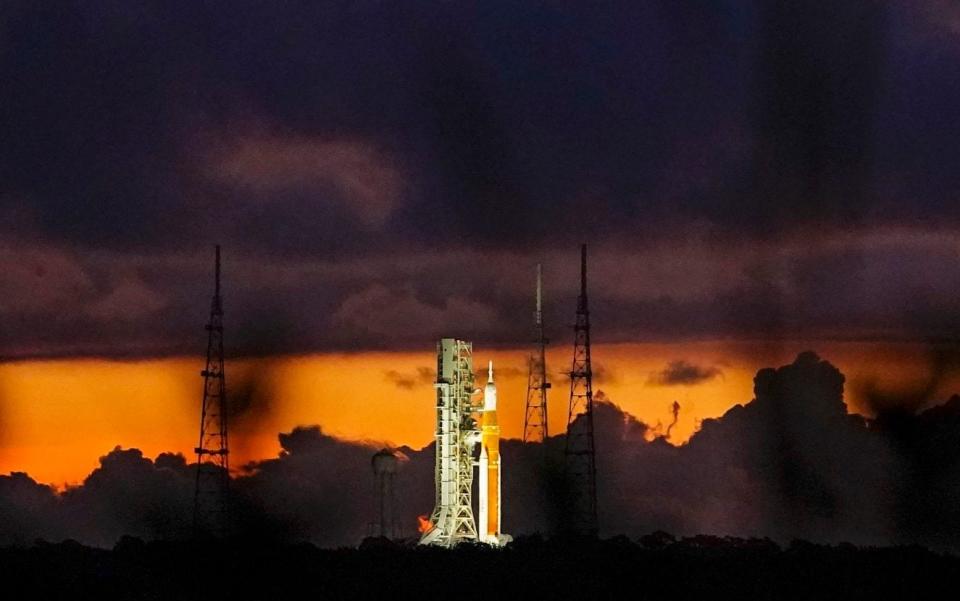
The motto of the Artemis mission has always been “We are going!”
But on Monday, it was clear Nasa’s mega Moon rocket was going nowhere, following a fraught eight hours which saw weather delays, a suspected crack in the thermal casing, a hydrogen leak and, finally, a fatal engine cooling problem.
Just minutes after the lift-off window opened at 8.33am local time in Florida, launch director Charlie Blackwell-Thompson took the decision to scrub the ascent, after engineers failed to find a solution to the coolant issue.
It is the latest compilation to beset the Artemis programme which was due to launch in 2021, but fell behind schedule before being hit by a string of technical failures during dummy runs earlier this year.
Now it appears that many issues are still to be ironed out, while new snags are only just emerging.
The cancellation was a bitter blow for the thousands who had flocked to the beaches around Cape Canaveral to watch the first launch of the Artemis mission, which has been billed as this generation’s Apollo and is aiming to put astronauts back on the lunar surface by 2025.
At Kennedy Space Centre, the fervour had been clear to see. From around lunchtime on Sunday cars, tents and campervans began building alongside the Indian and Banana rivers which separate the mainland from the cape.
Such was the mounting excitement that reporters and VIPs were advised to be at the press site at midnight, a full eight and a half hours before the launch window opened, to avoid traffic.

But problems started soon after, when a worrying lightning storm moved in from the south, delaying fuelling until it passed over.
Just as that system began to dissipate, a new weather cell was spotted in the north east and the green light to start filling the huge tanks was not given until 1.14am local time, leaving the launch an hour behind schedule.
Storms had dogged the mission all week, with one of the lightning towers surrounding the spacecraft suffering a direct hit on Saturday afternoon.
Launching in the volatile Florida summer is less than ideal, but technical issues earlier in the year left Nasa no choice but to try and get the mega Moon rocket up before the weather got worse.
Just as the weather cleared up, the launch was hit with another worrying issue - a hydrogen leak similar to the kind seen during April’s wet dress rehearsal, which caused the fuelling test to be scrubbed.
Although the problem was fixed, and the main tanks filled by 5am, a new crisis emerged almost immediately afterwards, with a suspected crack in the rocket’s thermal casing.
An investigation proved the issue was not fatal, but by then engineers had released engine number three was not cooling down sufficiently despite being flooded with liquid hydrogen.
It emerged that the system had never been tested in rehearsals. With time running out, and no solution presenting itself, Nasa abandoned the launch.
NOW: NASA Administrator @SenBillNelson speaks about today's #Artemis I launch attempt. https://t.co/l65YUBc4KI
— NASA (@NASA) August 29, 2022
US astronaut Stan Love, an advisor for the mission, said: “I came down here really hoping to see the smoke and fire but unfortunately we did not launch today.
“There was a problem with feeding cold gas into the engines before launch to prepare them for the shock of lighting and having all the propulsion suddenly flowing through them, they had to be in a very strict temperature range before they could do that.
“We’re not sure why, we’ve not sure when we can try again.”
It is unclear whether the rocket would have launched even if all the technical issues had been solved as it started to rain shortly after 8.30am. The Space Launch System (SLS) rocket cannot fly in the rain, and there are many other weather and temperature constraints which could have scuppered lift-off.
Speaking about the scrubbed launch, Bill Nelson, Nasa administrator, said: “We don’t launch until it’s right. I think it illustrates that this is a very complicated machine, a very complicated system and all of those things have to work.
“You don’t want to light the candle until it’s ready to go. I have some personal experience in the crew that I participated in on the space shuttle, we scrubbed four times, and on the fifth try, it was a flawless mission.
“This is just part of the space business and particularly a test flight, we are stressing and testing the spacecraft in a way that you would never do with a human crew on board, that is the purpose of the test flight.”
The earliest opportunity to launch again is 12.48pm Florida time on September 2nd or 5, but the US Space Agency said they did not know if it would have fixed the problem in time.
Nasa said it would not be draining the rocket of fuel immediately so that engineering teams could keep working on a solution to the cooling issue.
“We must wait to see what shakes out from the test data they are currently gathering now, and a decision will be made by the launch team about where to from here,” said Derrol Nail from Nasa Communications.
But time is running out as Florida weather is only expected to get worse as the state enters hurricane season. Four systems are currently brewing in the Atlantic, and weather forecasters said it was possible there could be named storms by the time the new window rolls around toward the end of the week.
03:31 PM
That's all for today
Thank you for following our live coverage of Artemis 1's failed launch. The day provided many twists and turns but, ultimately, planned space mission could not go ahead.
Artemis 1 had fixed its initial hydrogen-leak issue and it was looking like it could launch within the given time window. However, engineers were unable to cool engine 3 and the planned expedition had to be called off. Nasa said the two-hour launch window did not give engineers enough time to troubleshoot and fix the engine.
While the decision to scrub Artemis 1 left the scientific community devastated, many accepted that the rocket could not fly in the state that it was in.
We hope that you stay with us for the next attempted launch, scheduled for September 2.
03:15 PM
Dates for your diary
The next scheduled dates for launch are on September 2 and 5. Nasa will hope to learn lessons from today and they will also be crossing their fingers for unproblematic weather conditions on the forthcoming launch days.
03:00 PM
Nasa: 'We ran out of time'
Nasa has blamed the postponement of Artemis 1 on a lack of time within its two-hour launch window.
In an official statement, Nasa said: "The launch director halted today's Artemis I launch attempt at approximately 8:34 a.m. EDT.
"The Space Launch System rocket and Orion spacecraft remain in a safe and stable configuration.
"Launch controllers were continuing to evaluate why a bleed test to get the RS-25 engines on the bottom of the core stage to the proper temperature range for lift off was not successful, and ran out of time in the two-hour launch window.
"Engineers are continuing to gather additional data."
02:49 PM
Tim Peake: 'Disappointing but absolutely the right decision'
Disappointing but absolutely the right decision not to launch with an engine problem. Hopefully it can be resolved in time for the next window on 2 Sep. #Artemis1 🚀 https://t.co/CYvYuNsiV2
— Tim Peake (@astro_timpeake) August 29, 2022
02:23 PM
Nasa's Bill Nelson: 'We don't launch until it's right'
Speaking about the scrubbed launch, Nasa administrator Bill Nelson said: “We don’t launch until it’s right. I think it illustrates that this is a very complicated machine, a very complicated system and all of those things have to work.
"You don’t want to light the candle until it’s ready to go. I have some personal experience in the crew that I participated in on the space shuttle, we scrubbed four times, and on the fifth try it was a flawless mission.
"This is just part of the space business and particularly a test flight, we are stressing and testing the spacecraft in a way that you would never do with a human crew on board, that is the purpose of the test-flight."
02:21 PM
So many disappointed faces
The space community arriving at Cape Canaveral for #Artemis1 pic.twitter.com/YiHOU9tVtv
— Supercluster (@SuperclusterHQ) August 28, 2022
02:06 PM
Nasa react to the scrubbed mission
The launch of #Artemis I is no longer happening today as teams work through an issue with an engine bleed. Teams will continue to gather data, and we will keep you posted on the timing of the next launch attempt. https://t.co/tQ0lp6Ruhv pic.twitter.com/u6Uiim2mom
— NASA (@NASA) August 29, 2022
02:03 PM
United States Representative reacts
Launch scrubbed. While I'm excited about our return to the moon, I'm glad to see a focus on safety and success. Always listen to the experts. To be continued. #Artemis1 https://t.co/hJcHDy7ydX
— Rep. Val Demings (@RepValDemings) August 29, 2022
01:52 PM
Failure to launch for $93 billion project
Artemis 1 is part of a project that will cost $93bn in US taxpayer money to fund. Critics had argued that private space companies, such as Blue Origin, funded by Jeff Bezos, and SpaceX, created by Elon Musk, are developing such technologies already. Artemis 1's failure to launch today will do little to sway doubters of the project.
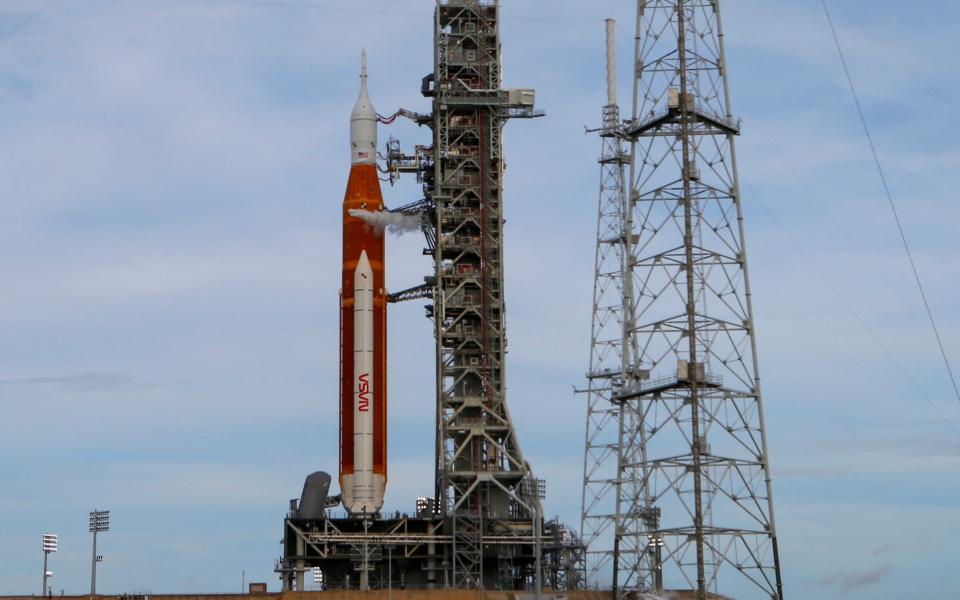
01:39 PM
Breaking: Artemis called off until further notice
Our Science Editor, Sarah Knapton, has confirmed that the mission has been called off for today. Stay with us for further updates.
01:33 PM
Launch window open but mission still in doubt
The launch window is now open, but the countdown clock has not restarted, making it likely the mission will now be scrubbed,
Mission launch director Charlie Blackwell-Thompson said the team is still working on a troubleshooting plan for cooling engine 3.
Engineers are going over modelling data, and are expected to report back imminently. But it's not looking hopeful.
01:27 PM
Mission under threat
We’re around 15 minutes from when the two-hour launch window opens and the countdown clock is still paused at the Kennedy Space Centre, reports our Science Editor, Sarah Knapton, who is out at the Kennedy Space Center.
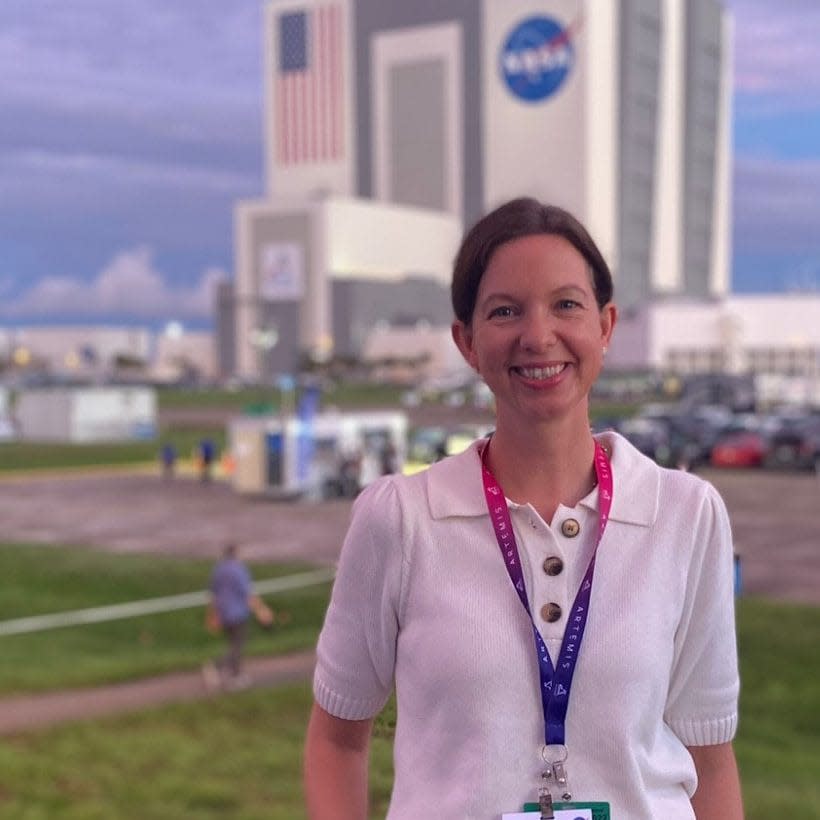

It turns out that the engine cooling system which is malfunctioning has never been tested, and engineers are desperately trying to find a work-around for the issue. But the mission is rapidly running out of time and the chance of the launch being scrubbed is growing with each passing minute.
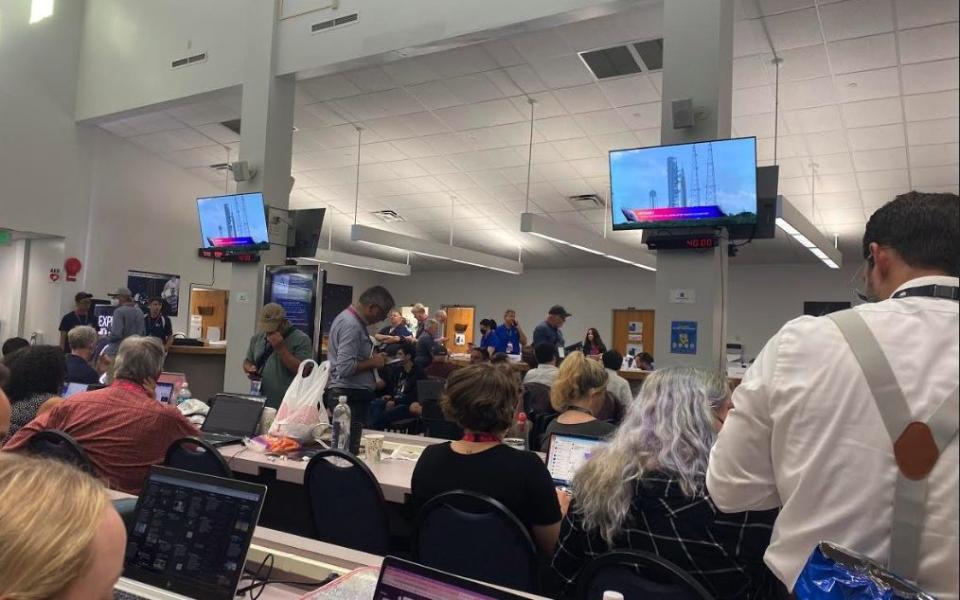
Most of the press have been here for at least eight hours now, and the mood in the newsroom is a becoming a little subdued.
12:58 PM
Early risers excited over Artemis 1 launch
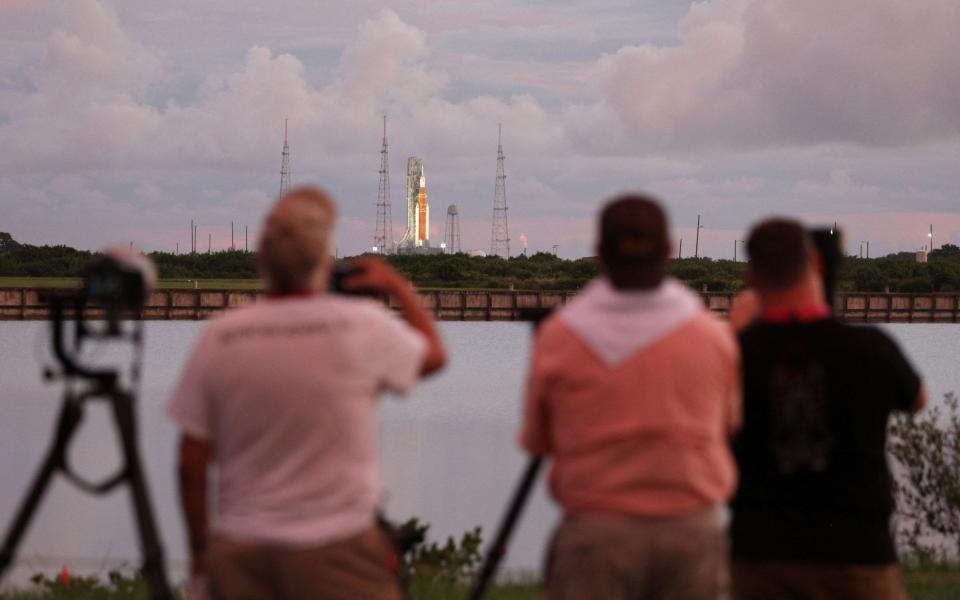
12:53 PM
The Sun rises over Artemis 1
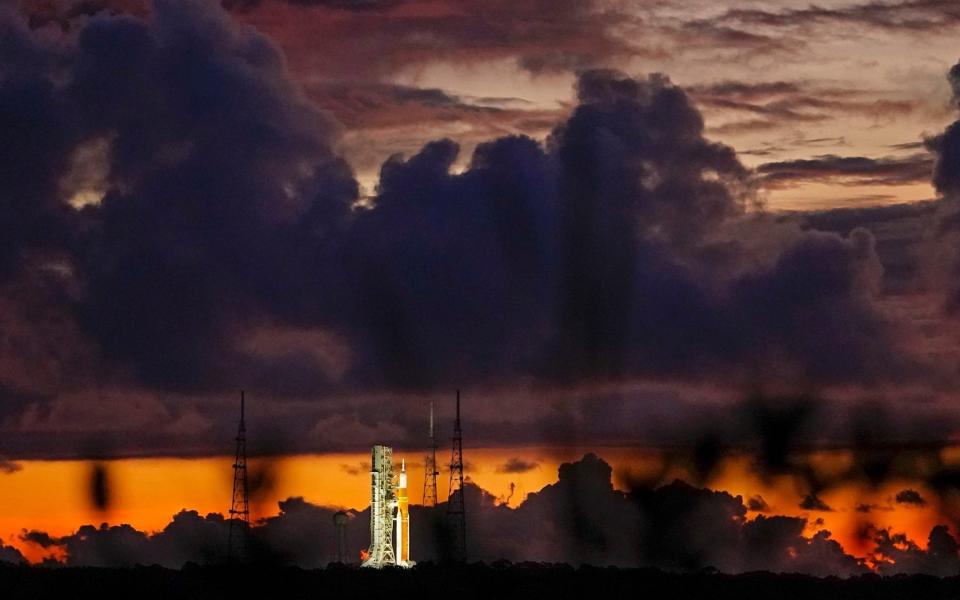
12:43 PM
Another problem solved
Some good news. The suspected crack in the thermal protection system in the core stage is not structural and unlikely to be a problem for launch.
Engineers say air is being sucked into foam on the tank and coming out as frost, making it look like the outside has a fissure. So one issue has been fixed.
Now they just need to sort out the engine cooling problem and we’re good to go. Expecting to get an update from the hydrogen team shortly.
12:38 PM
Waiting in the wings
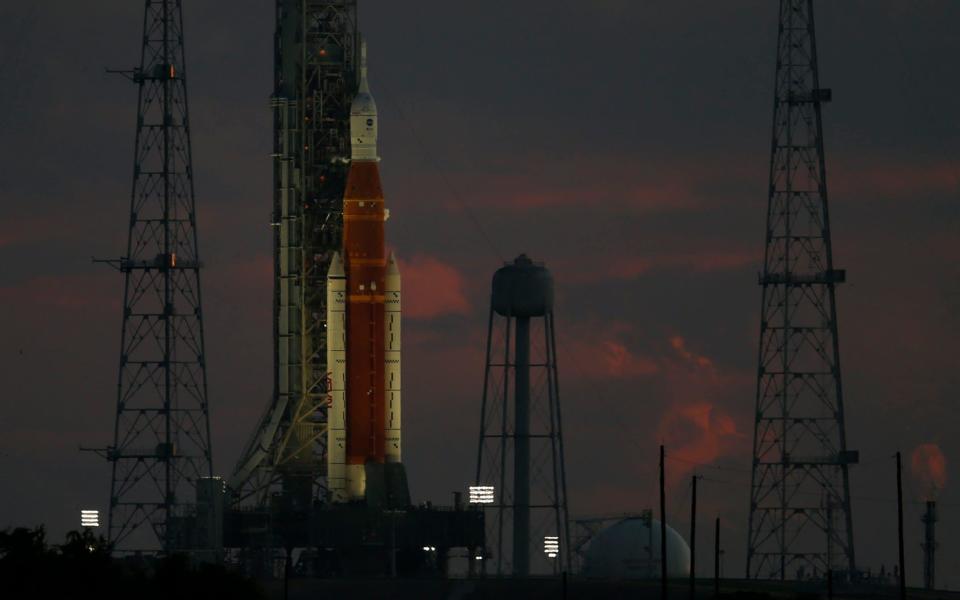
12:27 PM
Nasa stops its countdown
Nasa has stopped the countdown clock 40 minutes from launch as it continues to work out a fix for its engine cooling problem.
The engineering team has asked for 10 more minutes to come up with a solution.
This means that Artemis is unlikely to lift off at its earliest time of 8.33amET (1.33pmBST) It has a two hour window from which to launch.
12:22 PM
Launch not looking hopeful
Less than 45 minutes before the original launch time of 8.33am (1.33pm BST) and things are not looking overly hopeful.
The engines needed to be cool but there has been a problem with getting enough liquid hydrogen into engine three to bring the temperature down sufficiently for launch.
Nasa has currently suspended its launch broadcast while it troubleshoots the problem.
12:11 PM
Artemis 1 to be joined by Alexa
The Space Launch System (SLS) Mega Moon rocket will send an Orion spacecraft to the moon, aided by Amazon's Alexa. It will be used to control a variety of personal devices, such as phones and speaker devices. Alexa will help with the technological aspects of Artemis 1's mission in a process called Callisto.
Callisto will showcase artificial intelligence in collaboration with Orion manufacturer Lockheed Martin.
Lisa Callahan, vice president and general manager of commercial civil space for Lockheed Martin, said: "Callisto will demonstrate a first-of-its-kind technology that could be used in the future to enable astronauts to be more self-reliant as they explore deep space."
We hope that this is not a repeat of HAL 9000 from 2001: A Space Odyssey!
11:25 AM
Very little rest for some of the astronauts
Two hours sleep ✅ Blue flight suit ✅ 🇮🇹 + 🇩🇪 + 🇫🇷 ✅ go #Artemis1! pic.twitter.com/3lW5BcsvV6
— Thomas Pesquet (@Thom_astro) August 29, 2022
11:12 AM
New challenge arises for Artemis team
Artemis is now facing a new problem. The team needs to send liquid hydrogen through the engines to cool them to the right temperature, but so far only three of the four engines are cooling down sufficiently.
The team is planning to increase the pressure of the flow of liquid hydrogen to try and fix the problem.
11:07 AM
Excitement is building
This morning I had my first look at the fully assembled #Artemis1 rocket - I’m speechless! Years of dreams and exceptional hard work at @NASA have paid off - WE ARE GOING! Launch window to the Moon opens at 08:33 ET tomorrow! Follow along: https://t.co/6mIYz4bUa5 pic.twitter.com/nBgt78ecxp
— Jessica Meir (@Astro_Jessica) August 28, 2022
10:56 AM
Artemis 1 prepares to launch
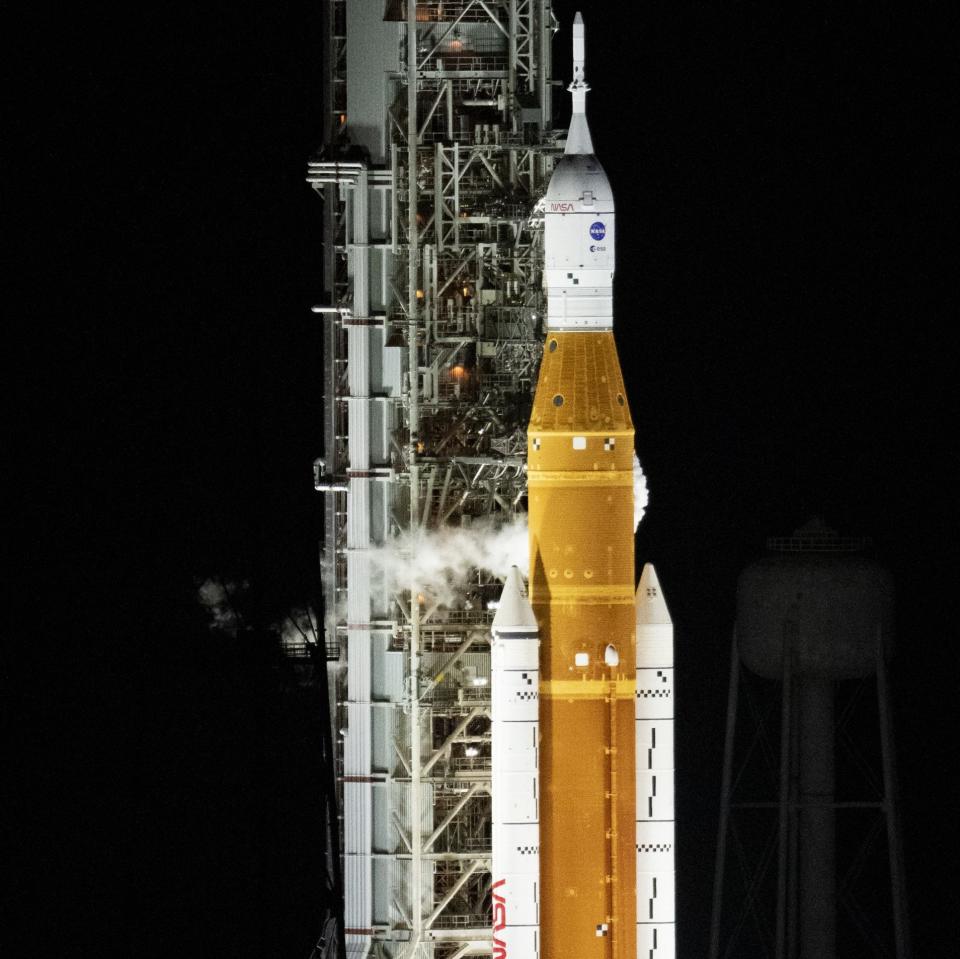
10:50 AM
Team in 'great shape' after hydrogen-leak fix
Speaking about the problems this morning, Jeremy Graeber, assistant launch director: “As we started to get ready to pick up with our cryogenic loading operation we noticed some storms in the south which had the possibility of lightning so we just had to wait until those storms cleared and got to outside of the five mile radius. Once that was completed we were able to keep going but there was a delay of just under an hour.”
Speaking about the hydrogen leak, he added: “We did some troubleshooting to understand where that leak was coming from and we went back into a slow fill and we got some more hydrogen onto the core stage and it allowed for all of the equipment to balance out and get to a very cold tank and that allowed for us to see that leak flatten out below our limits.
“Then they were able to increase up to fast fill and we have not had an increase in the leak.
“We are in really great shape. The team did a great job in working through that problem and getting us through it.”
Graeber said it was unclear how much time had been lost from the weather and hydrogen leak, but said the team were speeding up as much as possible to try and preserve as much as the two hour launch window as possible.
10:44 AM
What is Artemis 1?
Artemis 1 is an unmanned Moon-orbiting mission that is aiming to open up the possibility of human exploration on the Moon and Mars. It is the first of many space exploration projects that is being planned by Nasa.
After these missions, if all goes to plan, a new set of astronauts will travel to the Moon in 2025. They would be the first humans to stand on the surface of the Moon since Gene Cernan and Harrison Schmitt, in December 1972, who were the Apollo 17 astronauts.
Below shows an illustration of what we expect the upcoming mission to look like and the forecasted timeline of future missions.
10:31 AM
Why rockets can't take off in the rain
Our Science Editor, Sarah Knapton, explains why rain can damage rockets.
When they go supersonic it the turns the rain into little bullets which can damage the rocket. You can build them to resist it like Russia does.
— sarahknapton (@sarahknapton) August 29, 2022
10:10 AM
Suspected hydrogen leak appears to be fixed
The suspected hydrogen leak appears to be fixed now and the core stage tanks are nearly full.
Looking like we are back on track for a launch.
Derrel Nail, of Nasa Communications, said: "We are looking good so far."

 Yahoo News
Yahoo News 